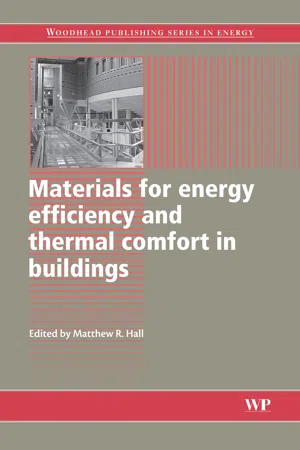
- 760 pages
- English
- ePUB (mobile friendly)
- Available on iOS & Android
Materials for Energy Efficiency and Thermal Comfort in Buildings
About this book
Almost half of the total energy produced in the developed world is inefficiently used to heat, cool, ventilate and control humidity in buildings, to meet the increasingly high thermal comfort levels demanded by occupants. The utilisation of advanced materials and passive technologies in buildings would substantially reduce the energy demand and improve the environmental impact and carbon footprint of building stock worldwide.Materials for energy efficiency and thermal comfort in buildings critically reviews the advanced building materials applicable for improving the built environment. Part one reviews both fundamental building physics and occupant comfort in buildings, from heat and mass transport, hygrothermal behaviour, and ventilation, on to thermal comfort and health and safety requirements.Part two details the development of advanced materials and sustainable technologies for application in buildings, beginning with a review of lifecycle assessment and environmental profiling of materials. The section moves on to review thermal insulation materials, materials for heat and moisture control, and heat energy storage and passive cooling technologies. Part two concludes with coverage of modern methods of construction, roofing design and technology, and benchmarking of façades for optimised building thermal performance.Finally, Part three reviews the application of advanced materials, design and technologies in a range of existing and new building types, including domestic, commercial and high-performance buildings, and buildings in hot and tropical climates.This book is of particular use to, mechanical, electrical and HVAC engineers, architects and low-energy building practitioners worldwide, as well as to academics and researchers in the fields of building physics, civil and building engineering, and materials science.- Explores improving energy efficiency and thermal comfort through material selection and sustainable technologies- Documents the development of advanced materials and sustainable technologies for applications in building design and construction- Examines fundamental building physics and occupant comfort in buildings featuring heat and mass transport, hygrothermal behaviour and ventilation
Frequently asked questions
- Essential is ideal for learners and professionals who enjoy exploring a wide range of subjects. Access the Essential Library with 800,000+ trusted titles and best-sellers across business, personal growth, and the humanities. Includes unlimited reading time and Standard Read Aloud voice.
- Complete: Perfect for advanced learners and researchers needing full, unrestricted access. Unlock 1.4M+ books across hundreds of subjects, including academic and specialized titles. The Complete Plan also includes advanced features like Premium Read Aloud and Research Assistant.
Please note we cannot support devices running on iOS 13 and Android 7 or earlier. Learn more about using the app.
Information
Heat and mass transport processes in building materials
Abstract:
1.1 Introduction
1.1.1 Laws of thermodynamics
Table of contents
- Cover image
- Title page
- Table of Contents
- Copyright
- Contributor contact details
- Woodhead Publishing Series in Energy
- Preface
- This publication was sponsored by The Austin Company of UK Limited
- Part I: Fundamental issues and building physics: understanding energy efficiency and thermal comfort in the built environment
- Part II: Materials and sustainable technologies: improving energy efficiency and thermal comfort in the built environment
- Part III: Application of advanced building materials and design: improving energy efficiency and thermal comfort in the built environment
- Index